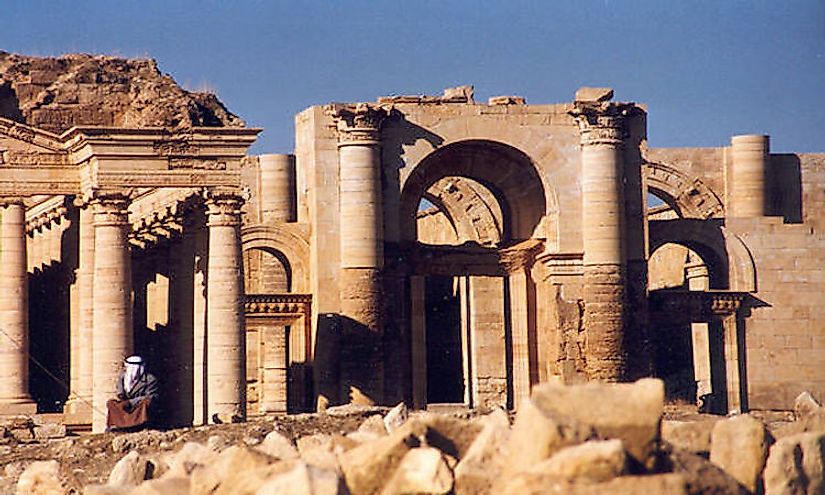UNESCO World Heritage Sites In Iraq

The country of Iraq is located in Western Asia in the heart of the Middle East region. The region that is now known as Iraq has a long history stretching back to the ancient Mesopotamia, known as the cradle of civilization and the ancient civilization of Sumer. Iraq currently hosts five different UNESCO World Heritage Sites.
Some of Iraq's UNESCO World Heritage Sites
Hatra
Hatra was designated as the first UNESCO World Heritage site in Iraq back in 1985 and is located in the Governorate of Ninawa in northwest Iraq. The ruins of Hatra was a large fortified city that served as a religious and trading center as of the Kingdom of Araba, which was a semi-autonomous buffer kingdom that was under the influence of the Parthian Empire (247 BC to 224 AD). The city was able to withstand two attacks by the Roman Empire (27-476) during the Roman–Parthian Wars (66 BC – 217 AD), but eventually fell to the Sassanid Empire (224-651) in 241. The ruins of the city today serve as the most well-preserved example of a city from the Parthian Empire, and the buildings and temples of the town show the fusion of the Hellenistic and Roman architecture with the decorative features of the Eastern cultures.
Ashur (Qal'at Sherqat)
The Ashur site, also known as Qal'at Sherqat, was designated as a UNESCO World Heritage site in Iraq in 2003 and is located in the Governorate of Salah ad Din in the north-central part of the country. The city of Ashur is located on the Tigris River that flows through Iraq, and the city was founded at some point around 2,500 BC during the Mesopotamia era. The city was the capital of the Assyrian Empire (2,500-612 BC) from the 14th to the 9th century and was a very important trading location and religious capital. The city was sacked at some point by the Babylonians and did not fully recover until the Parthian Empire controlled the city from the 1st century AD until the Romans sacked it in 257. After this, the city was well populated until the 14th century before Timur (1336-1405), the founder of the Timurid Empire (1370-1507) sacked the city and butchered the native Nestorians living there. The city today serves as an important example of the past Assyrian Empire.
Ahwar of Southern Iraq - Biodiversity Refuge and Relic Cities of Mesopotamia
The Ahwar of Southern Iraq was designated as a UNESCO World Heritage Site in 2016 making it the newest one in the country. The Ahwar of Southern Iraq is located in the Basra Governorate in the southeastern part of the country. The site is a combination of seven different areas, the Uruk, Ur and Tell Eridu archaeological sites and the Huwaizah, Central, East Hammar and West Hammar marshes. The three archaeological sites together constitute the ruins of the three separate Sumerian town and settlements that developed in Mesopotamia between the 4th and 3rd millennium BC. These cities are located in the marshy delta, made up of the aforementioned four marshes, between the Tigris and Euphrates rivers. This marshy delta area is one of the largest inland delta systems in the world. This site is important for studying how towns developed in ancient Mesopotamia, as well as serving to protected one of the world's important natural areas in this large marshy delta.
The Integrity And Threats To Iraq's UNESCO World Heritage Sites
The Hatra UNESCO World Heritage Site has been heavily damaged and destroyed in the last two years since the terrorist organization of ISIS gained control of that area of Iraq. Not only has the site been damaged due to war between ISIS and the Joint Task Force of countries trying to defeat them, but the site has been deliberately destroyed by ISIS members who see the site as a challenge to their ideology and beliefs because of what it stands for. The Ashur site is also threatened by natural causes like flooding and from its fragile mud brick structures. The site is also threatened by human activities like inadequate site management and the ongoing war in Iraq with ISIS. The marshes at the Ahwar of Southern Iraq site were partially drained by the government in the 1970s and then massively drained in the 1990s which caused greater damage to the area. Since the early 2000's the area has been re-flooded, and the marshes have been slowly recovering, although they may never completely regenerate. The archaeological sites face challenges from erosion, neglect and inappropriate restoration of the site.
UNESCO World Heritage Sites In Iraq
| UNESCO World Heritage Sites In Iraq | Year of Inscription; Type |
| Ahwar of Southern Iraq - Biodiversity Refuge and Relic Cities of Mesopotamia | 2016; Mixed |
| Ashur (Qal'at Sherqat) | 2003; Cultural |
| Erbil Citadel | 2014; Cultural |
| Hatra | 1985; Cultural |
| Samarra Archaeological City | 2007; Cultural |







